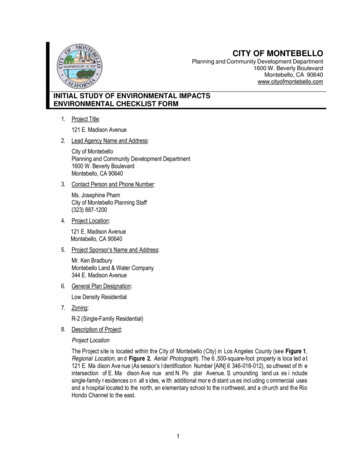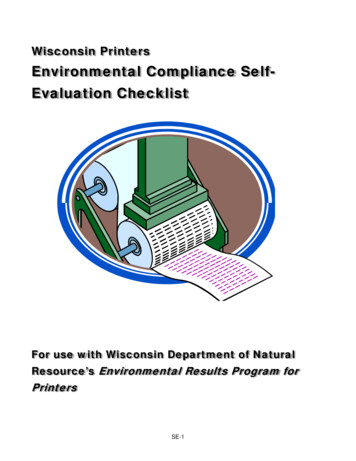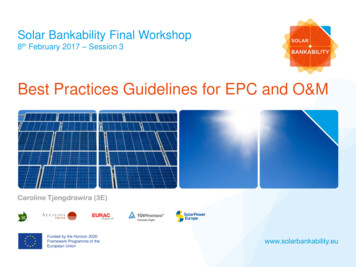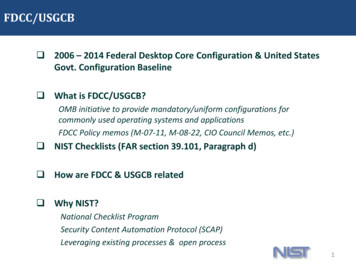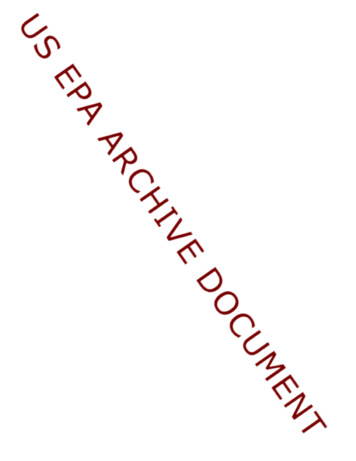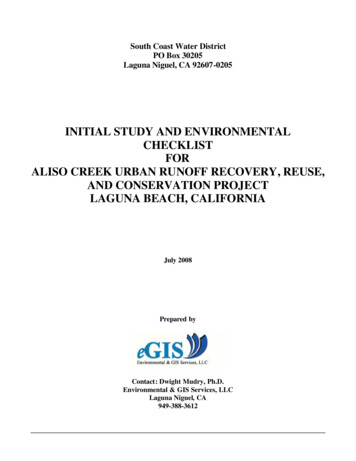
Transcription
South Coast Water DistrictPO Box 30205Laguna Niguel, CA 92607-0205INITIAL STUDY AND ENVIRONMENTALCHECKLISTFORALISO CREEK URBAN RUNOFF RECOVERY, REUSE,AND CONSERVATION PROJECTLAGUNA BEACH, CALIFORNIAJuly 2008Prepared byContact: Dwight Mudry, Ph.D.Environmental & GIS Services, LLCLaguna Niguel, CA949-388-3612
Initial StudyAliso Creek Urban Runoff Recovery, Reuse, & Conservation ProjectTABLE OF CONTENTS1.0 INTRODUCTION AND PURPOSE AND NEED .11.1 BACKGROUND .11.2 INITIAL STUDY DOCUMENT PURPOSE .22.0 PROJECT DESCRIPTION .52.1 PROJECT SETTING .52.2 RUNOFF WATER RECOVERY, TREATMENT, AND REUSE .52.2.1 Water Recovery.52.2.2 Waste Water Discharge .92.3 EXPECTED PROJECT BENEFITS .92.4 DESCRIPTION OF PROJECT TIMELINE.103.0 PERMITS AND APPROVALS NEEDED .114.0 DETERMINATION .124.1 ENVIRONMENTAL FACTORS POTENTIALLY AFFECTED .124.2 DETERMINATION.125.0 CEQA CHECKLIST AND EVALUATION OF POTENTIAL ENVIRONMENTAL IMPACTS .135.1 INITIAL STUDY CHECKLIST.145.2 DISCUSSION OF ENVIRONMENTAL IMPACTS .205.2.1 Aesthetics.205.2.2 Agricultural Resources.215.2.3 Air Quality .225.2.4 Biological Resources.235.2.5 Cultural Resources .265.2.6 Geology and Soils .275.2.7 Hazards and Hazardous Materials .285.2.8 Hydrology and Water Quality.305.2.9 Land Use and Planning .355.2.10 Mineral Resources.365.2.11 Noise .365.2.12 Population and Housing .385.2.13 Public Services .385.2.14 Recreation .395.2.15 Transportation and Traffic .395.2.16 Utilities and Service Systems.415.2.17 Mandatory Findings of Significance.426.0 REFERENCES CITED AND SUPPORTING INFORMATION SOURCES .447.0 LIST OF PREPARERS .45ATTACHMENTSA. Aliso Creek Hydrologic Conditions, Project Plans, and Adaptive ManagementB. Toxicity Analysis for the Wastewater DischargeSouth Coast Water Districti
Initial StudyAliso Creek Urban Runoff Recovery, Reuse, & Conservation Project1.0INTRODUCTION AND PURPOSE AND NEEDSouth Coast Water District (SCWD or “District”) proposes to capture and reuse approximately800,000 gallons per day (gpd) of urban runoff in Aliso Creek in Laguna Beach, California(Figures 1-1 and 1-2). The recovered urban runoff collected by the Aliso Creek urban runoffrecovery, reuse and conservation project (“Project”) will be treated and reused by combining thewater with recycled water produced at the Advanced Wastewater Treatment (AWT) System atthe Coastal Treatment Plant (CTP). There will be an improvement to the water quality of thecombined supply, making the AWT recycled water more usable as well as increasing the overallrecycled water supply for South Laguna, Dana Point, and Capistrano Beach. Downstreamimprovements in water quality are expected at Aliso Beach County Park because a portion of theurban runoff will be removed from Aliso Creek and constituents removed from the runoff waterwill be discharged in the Coastal Treatment Plant outfall, approximately 6,700 feet offshore at adepth of approximately 170 feet. Removal of a portion of the urban runoff will also help toreduce excessive stream flow from urbanized areas and return stream flows in lower Aliso Creekto more natural levels.1.1BACKGROUNDSCWD is a retail water agency organized and existing as a County Water District under Section30,000 et seq. of the California Water Code. The SCWD serves approximately 12,500 wateraccounts with an estimated winter population of 40,000 1 in the South Laguna and Dana Pointareas.The SCWD imports approximately 7,500 acre- feet (6.7 million gallons per day [gpd]) of potablewater on a yearly basis. The SCWD maintains approximately 32 million gallons of water storagein 15 area reservoirs (an approximately 4.8-day water supply). The SCWD service area has beenidentified by the Bureau of Reclamation as an area of “Potential Water Supply Crisis” by 2025.2The SCWD’s wholesale water providers, the Municipal Water District of Orange County(MWDOC) and the Metropolitan Water District (MWD), have encouraged the development ofalternative local water supply sources within the area served by SCWD. 3In 1982, the SCWD obtained State Grant funding to construct the AWT system at the CTP as anadditional source of water supply. SCWD contracted operation of the AWT to the South OrangeCounty Wastewater Authority (SOCWA) in 1996. 4 The AWT produces Title 22 recycled water,which is delivered via pipelines south of Pacific Coast Highway to recycled water customerswithin the SCWD service area. Existing recycled water customers include the Montage Resort,Lang Park, Monarch Links Golf Course at the St. Regis Resort, Niguel Shores CommunityAssociation, the Dana Hills High School, the City of Dana Point parks and the CaliforniaDepartment of Transportation (CalTrans) highway median areas. These customers use the1Summer populations in the area vary dramatically due to the presence of beach resorts.Bureau of Reclamation “Water 2025 Report”.3MWD Integrated Resources Water Management Plan.4SOCWA member agencies include SCWD and 9 other sewer agencies. SOCWA is a Joint PowersAuthority (JPA) formed in 2001 to treat wastewater at several regional facilities in south Orange Countyincluding the CTP.2South Coast Water District1
Initial StudyAliso Creek Urban Runoff Recovery, Reuse, & Conservation Projectrecycled water for non-potable applications, primary landscape irrigation. During some portionsof the year, demand for recycled water in the service area is approximately 500,000 gpd.Since 1995, the recycled water produced at the AWT has exhibited elevated Total DissolvedSolids (TDS) content. The TDS content of the recycled water has consistently measured greaterthan 1,000 milligrams per liter (mg/L), which has made the recycled water supply unattractive tosome customers. The use of water containing elevated TDS is particularly difficult for golfcourses, since the high salt content from the water is trapped in the soil and kills grass roots.Customers that are not able to utilize the recyc led water with the elevate TDS content use thepotable water supply for their purposes.To remedy the elevated TDS at the CTP, the SCWD proposes to capture and use up toapproximately 800,000 gallons per day (gpd) of urban runoff from the nearby Aliso Creek. Therecovered urban runoff will be treated and reused at the CTP by combining the treated runoffwater with recycled water already produced at the CTP.Since the proposed project involves the removal of water from the nearby Aliso Creek, theattached Aliso Creek Hydrologic Conditions, Project Plans, and Adaptive Management report(Hydrologic Report) (Attachment A) was prepared. This Hydrologic Report was also prepared toprovide information needed by the California Department of Fish and Game (CDFG) tocomplete their review of the project.The project is described in greater detail in Section 2.0 of this document.1.2INITIAL STUDY DOCUMENT PURPOSEBecause the project has the potential for environmental impacts, this action would constitute aproject under the California Environmental Quality Act (CEQA) and require environmentalreview by SCWD. In accordance with CEQA (Public Resources Code Sections 21 00021 177)and pursuant to Section 15063 of the California Code of Regulations (CCR), the SCWD, actingin the capacity of Lead Agency, has prepared this Initial Study to determine whether theproposed project would have a significant environmental impact. It has been determined that theproject is discretionary in nature and is not otherwise exempt from the requirements of CEQA.This Initial Study has been prepared pursuant to the State Guidelines for implementing CEQA.South Coast Water District2
Initial StudySouth Coast Water DistrictAliso Creek Urban Runoff Recovery, Reuse, & Conservation Project3
Initial StudySouth Coast Water DistrictAliso Creek Urban Runoff Recovery, Reuse, & Conservation Project4
Initial StudyAliso Creek Urban Runoff Recovery, Reuse, & Conservation Project2.0 PROJECT DESCRIPTIONThis section presents additional detail regarding the project implementation and expected projectbenefits.2.1PROJECT SETTINGAs described in Section 1.0, the project area is within the Aliso Creek Watershed downstream ofthe Aliso and Wood Canyons Wilderness Park and is approximately 1.5 miles from theconfluence of the creek into the Pacific Ocean at Aliso Beach County Park, a popular beachdestination and water sport location. The Aliso Creek Inn and Golf Course is located adjacent toAliso Creek between Pacific Coast Highway and AWT system at the CTP.2.2RUNOFF WATER RECOVERY, TREATMENT, AND REUSEThe following sections detail the proposed water system design and construction methods:2.2.1Water RecoveryThis project proposes to recover abandoned urban runoff water from Aliso Creek. The waterintake equipment will be located near the bridge that provides access to the CTP (Figure 2-1).Urban runoff water will be recovered from Aliso Creek using a self-priming centrifugal pumpwith a self-cleaning intake screen mounted next to an existing concrete apron. The stream banksat this location are protected from erosion by concrete and rip-rap. The water intake pump willbe secured by bolts to the existing concrete apron and will not require alteration of thestreambed.A 7.5-horsepower float controlledpump will deliver water to thetreatment facility via a 40- inchdiameter PVC pipeline. The pumpwillbeplacedinsideanapproximately two-foot by 1- footpump suction screen (Figure 2-2),which will prevent unwantedmaterial from passing into the pumpto protect the dual media filtrationsystem.Stream GaugeExistingConcrete WeirScreen LocationFigure 2-1. Location of Pump Screen in Aliso CreekSouth Coast Water District5
Initial StudyAliso Creek Urban Runoff Recovery, Reuse, & Conservation ProjectFigure 2-2. Self-Cleaning Pump Suction Screen (actual size: 2 feet by 1 foot)During storm events or at very low volume, water will likely be of poor quality with highturbidity. Additionally, rainfall will reduce the demand for use of recycled water forirrigation. Therefore, water will not be recovered from Aliso Creek during high flows or duringvery low flows. The water intake system will include controls and sensors to monitor not onlysystem operations but also external operating parameters. Level sensors will shut down thesystem if the creek level is too high or too low and the system will also be programmed to shutoff if the influent turbidity reaches a programmable set point. These system controls will be tiedinto the internet-based control system.Recovered Water Treatment ProcessThe water will be treated with a reverse osmosis (RO) and a filtration package system to providerecycled water with a lower TDS content than is currently available to recycled water customers.Water treatment equipment will be located on an existing asphalt pad adjacent to the AWTdisinfection system illustrated in Figure 2-3.South Coast Water District6
Initial StudyAliso Creek Urban Runoff Recovery, Reuse, & Conservation ProjectFigure 2-3. Existing Asphalt Area for Equipment PlacementThe treatment equipment will consist of a package treatment plant installation (Clear CreekSystem, or equivalent), including:o Multi- media filters - approximately four tanks 48- inch diameter and 60- inch high –containing filter materialo Two tanks for organoclay filters (approximately 48- inch diameter, 72- inch height)o RO treatment systemo Control panels.A diagram indicating the water collection, treatment and use cycle is shown in Figure 2-4. Figure2-5 is a photograph of a similar system.South Coast Water District7
Initial StudyAliso Creek Urban Runoff Recovery, Reuse, & Conservation ProjectFigure 2.4. Typical Water Collection and Treatment Cycle, Urban Run-off Water RecyclingSystemFigure 2-5. Depiction of Similar Package Treatment InstallationThe water will be filtered through four 48- inch diameter dual media (sand and anthracite)pressure filters, operating in parallel. In this filtration method, water enters the top of each filtervessel and flows, under pressure, through media where solid particulate and suspended organicand inorganic solids are removed. The filters operate at 11 gallons per minute per square foot fora designed rate of 600 gpm. Filters are backwashed periodically to remove trapped materials,South Coast Water District8
Initial StudyAliso Creek Urban Runoff Recovery, Reuse, & Conservation Projectusing water from the potable water system. The backwash is discharged to the backwash wastetank where the water is conveyed to the headworks of the CTP. The filtered water will then flowthrough a reverse osmosis unit using two banks of low-energy reverse osmosis membranes tooptimize energy efficiency. The recovered water is anticipated to have approximately 200 mg/lof dissolved solids and a 60 to 75 percent recovery rate, depending on water quality.The water exits the treatment system and is delivered by pipeline to the adjacent AWTdisinfection system where it is blended with the secondary treated effluent entering the AWTfrom the CTP. The end product water will be stored for use in the recycled water system anddelivered in accordance with all requirements of the AWT’s existing permits for the delivery anduse of recycled water.2.2.2Waste Water DischargeThe CPT has utilized an ocean outfall since 1979. The outfall extends 7,900 feet offshoresouthwest from the mouth of Aliso Creek. The inshore end of the diffuser is locatedapproximately 6,700 feet offshore at a depth of approximately 170 feet. The diffuser, which iscollinear with the rest of the outfall, is approximately 1,200 feet long and extends to a maximumdepth of 195 feet. The design capacity of the ocean outfall is 50 million gallons per day (MGD).Concentrated effluent (brine) from the RO system and backwash from the filtration package isthe expected by-product of the packaged treatment system and will be directed to the ocean viathe existing outfall. Clear Creek Systems, Inc., processed creek water using a portable testsystem on May 14, 2008. Effluent from the RO and filter process was analyzed using the sameprocedures as SOCWA’s regular NPDES permit requirements for monthly toxicity monitoring.The results of the constituent analysis and toxicity testing are provided in Attachment B. Therewas no observed toxicity in the chronic kelp germination and growth test. However, there was atoxic effect observed in the 100% effluent concentration for the acute mysid survival test. Thisresulted in an acute toxicity unit value of 1.30, which is within the CTP and AWT permiteffluent limits.A maximum of 100 acre- feet of brine (approximately 300,000 gpd) will be discharged annuallyvia the existing outfall. This volume represents approximately 0.5 to 0.8 percent of the total flowvolume in the outfall. Based on the testing conducted the brine will be of similar quality as thewater entering the outfall from the CTP secondary treatment process. Because constituents in thewater diverted from the creek will be discharged to the ocean via the outfall, no increase innutrient loads to the ocean are expected from this project.2.3EXPECTED PROJECT BENEFITSAs detailed below, the project has three major expected benefits:o Increasing and improving recycled water supply – The proposed project wouldincrease and improve an alternative water supply (recycled, tertiary treated water) bylowering the TDS in the total recycled water supply and improving the quantity andquality of recycled water delivered by SCWD to recycled water customers. The SCWD’sSouth Coast Water District9
Initial StudyAliso Creek Urban Runoff Recovery, Reuse, & Conservation Projectwholesale water providers, MWDOC and MWD, have encouraged the development ofalternative local water supply sources within the area served by SCWD. The projectwould allow the SCWD to serve more recycled water to available customers. The projectis also consistent with public policy as determined by the California Legislature, whichdeclares that the use of potable domestic water for non-potable uses is a waste where arecycled water supply is available.o Improving Aliso Creek Beach and Recreation Areas - The proposed project wouldimprove Aliso Creek beach and recreation areas in the surrounding ocean environment byreducing the polluting impact of abandoned urban runoff in these areas. Up to 800,000gpd (approximately 1.23 cubic feet per second (cfs)) of dry season flows will beintercepted and removed from Aliso Creek. By removing this warm, nutrient-rich andbacteria-laden runoff currently flowing into the tidal zone in the vicinity of Aliso Creek,beach conditions and the near-shore ocean water quality will be improved.o Help to Restore Aliso Creek to Natural Conditions - The proposed project wouldreduce the average flow of Aliso Creek to bring it closer to historic levels that existedbefore urbanization in upstream areas caused an increase in flows. Historically, the creekhad much lower flows during the rainy seasons and little or no flow during summermonths (discussed further in Section 5.2.8, below). The historic conditions allowed theformation of beach sand barriers and formation of pooled areas, where the endangeredtidewater goby was found. It is believed that the extensive and costly erosion of the lowerreach of Aliso Watershed is the direct result of development- induced elevated flow ratesfrom upstream areas. The current increased flow rates are also responsible fortransporting bacteria and other contaminates to the ocean receiving waters anddestruction of the favorable former wetland/tide pool habitat of the tidewater goby.2.4DESCRIPTION OF PROJECT TIMELINEConstruction activities are expected to last approximately 2 to 4 weeks. The Project will operateover a ten year period.South Coast Water District10
Initial StudyAliso Creek Urban Runoff Recovery, Reuse, & Conservation Project3.0 PERMITS AND APPROVALS NEEDEDThe following environmental documentation, permits and approvals may be required for implementationof the proposed project:ooooooCalifornia Fish and Game Streambed Alteration Agreement.California Coastal Commission, Coastal Development PermitCRWQCB Ocean Discharge Permit (Addendum)CRWQCB Recycled Water Permit (Amendment)State Water Resources Control Board Application to Appropriate WaterCounty of Orange Encroachment PermitSouth Coast Water District11
Initial StudyAliso Creek Urban Runoff Recovery, Reuse, & Conservation Project4.0 DETERMINATION4.1ENVIRONMENTAL FACTORS POTENTIALLY AFFECTEDThe environmental factors checked below (X) have been determined to be potentially affected by thisproject.AestheticsAgriculture ResourcesAir QualityBiological ResourcesCultural ResourcesGeology/SoilsHazards & Hazardous MaterialsHydrology/Water QualityLand Use/PlanningMineral ResourcesNoisePopulation/HousingPublic Service SystemsOtherMandatory Findings of SignificanceAt least one impact that is a “Significant Impact” or “Less than Significant with MitigationIncorporated,” has been identified, as detailed in the CEQA checklist portion of this document (Section5.0).4.2DETERMINATIONOn the basis of this initial evaluation:I find that the proposed project COULD NOT have a significant effect on the environment,and a NEGATIVE DECLARATION will be prepared.I find that although the proposed project could have a significant effect on the environment,there will not be a significant effect in this case because revisions in the project, described inthis document, have been made or agreed to by the project proponent. A MITIGATEDNEGATIVE DECLAR ATION will be prepared.I find that the proposed project MAY have a significant effect on the environment, and anENVIRONMENTAL IMPACT REPORT is required.SignatureDateMike DunbarPrinted NameGeneral Manager, South Coast Water DistrictAgencySouth Coast Water District12
Initial StudyAliso Creek Urban Runoff Recovery, Reuse, & Conservation Project5.0 CEQA CHECKLIST AND EVALUATION OF POTENTIALENVIRONMENTAL IMPACTSThis section provides a discussion of potential environmental impacts associated with approval of theproposed project. CEQA provides the following guidance for the evaluation of impacts:1) A brief explanation is required for all answers except "No Impact" answers that are adequatelysupported by the information sources a lead agency cites in the parentheses following eachquestion. A "No Impact" answer is adequately supported if the referenced information showsthat the impact does not apply to projects like the one involved (e.g. the project falls outside afault rupture zone). A “No Impact” answer should be explained where it is based on projectspecific factors as well as general standards (e.g. the project will not expose sensitive receptorsto pollutants, based on a project-specific screening analysis).2) All answers must take account of the whole action involved, including off-site and on-siteimpacts, cumulative and project-level impacts, indirect and direct impacts, and construction andoperational impacts.3) "Potentially Significant Impact" determination is appropriate if there is substantial evidencethat an effect is significant. If there are one or more "Potentially Significant Impact" entrieswhen the determination is made, an EIR is required.4) "Less Than Significant With Mitigation Incorporated" applies where the incorporation ofmitigation measures has reduced an effect from "Potentially Significant Impact" to a "Less thanSignificant Impact." The lead agency must describe the mitigation measures, and brieflyexplain how they reduce the effect to a less than significant level.5) Earlier analysis may be used where, pursuant to the tiered, program EIR, or other CEQAprocess, an effect has been adequately analyzed in an earlier EIR or negative declaration.Section 15063 (c)(3)(d).6) Lead agencies are encouraged to incorporate into the checklist references to informationsources for potential impacts (e.g. general plans, zoning ordinances). Reference to a previouslyprepared or outside document should, where appropriate, include a reference to the page orpages where the statement is substantiated.South Coast Water District13
Initial Study5.1Aliso Creek Urban Runoff Recovery, Reuse, & Conservation ProjectINITIAL STUDY CHECKLISTThe following table (Table 5-1) presents the Initial Study checklist. Each item is discussed in furtherdetail in Section 5.2.TABLE 5 -1INITIAL STUDY Sa) Would the project have a substantial adverse effect on a scenicvista?b) Would the project substantially damage scenic resources,including, but not limited to trees, rock outcroppings, andhistoric buildings within a state scenic highway?c) Would the project substantially degrade the existing visualcharacter or quality of the site and its surroundings?d) Would the project create a new source of substantial light orglare which would adversely affect day or nighttime views inthe area?AGRICULTURAL RESOUCRESa) Would the project convert Prime Farmland, UniqueFarmland, or Farmland of Statewide Importance (Farmland),as shown on the maps prepared pursuant to the FarmlandMapping and Monitoring Program of the CaliforniaResources Agency, to non-agricultural use?b) Would the project conflict with existing zoning foragricultural use, or a Williamson Act contract?c) Would the project involve other changes in the existingenvironment, which due to their location or nature, couldresult in conversion of Farmland to nonagricultural use?AIR QUALITYa) Would the project conflict with or obstruct implementation ofthe applicable air quality plan?b) Would the project violate any air quality standard orcontribute substantially to an existing or projected air qualityviolation?c) Would the project result in a cumulatively considerable netincrease of any criteria pollutant for which the project regionis non-attainment under an applicable federal or state ambientair quality standard (including releasing emissions whichexceed quantitative thresholds for ozone precursors)?d) Would the project expose sensitive receptors to substantialpollutant concentrations?e) Would the project create objectionable odors affecting asubstantial number of people?South Coast Water District14Less ThanSignificant withMitigationIncorporatedLess ThanSignificantImpactNoImpact
Initial StudyAliso Creek Urban Runoff Recovery, Reuse, & Conservation ProjectTABLE 5 -1INITIAL STUDY L RESOURCESa) Would the project have a substantial adverse effect, eitherdirectly or through habitat modifications, on any speciesidentified as a candidate, sensitive, or special status species inlocal or regional plans, policies, or regulations, or by theCalifornia Department of Fish and Game or U.S. Fish andWildlife Service?b) Would the project have a substantial adverse effect on anyriparian habitat or other sensitive natural communityidentified in local or regional plans, policies, and regulationsor by the California Department of Fish and Game or US Fishand Wildlife Service?c) Would the project have a substantial adverse effect onfederally protected wetlands as defined by Section 404 of theClean Water Act (including, but not limited to, marsh, vernalpool, and/or coastal waters) through direct removal, filling,hydrological interruption, or other means?d) Would the proposal interfere substantially with the movementof any native resident or migratory fish or wildlife species orwith established native resident or migratory wildlifecorridors, or impede the use of native wildlife nursery sites?e) Would the proposal conflict with any local policies orordinances protecting biological resources, such as a treepreservation policy or ordinance?f) Would the project conflict with the provisions of an adoptedHabitat Conservation Plan, Natural Community ConservationPlan, or other approved local, regional, or state habitatconservation plan?CULTURAL RESOURCESa) Would the project cause a substantial adverse change in thesignificance of a historical resource as defined in §15064.5?b) Would the project cause a substantial adverse change in thesignificance of an archaeological resource pursuant to§15064.5?c) Would the project directly or indirectly destroy a uniquepaleontological resource or site or unique geologic feature?d) Would the project disturb any human remains, includingthose interred outside of formal cemeteries?South Coast Water District15Less ThanSignificant withMitigationIncorporatedLess ThanSignificantImpactNoImpact
Initial StudyAliso Creek Urban Runoff Recovery, Reuse, & Conservation ProjectTABLE 5 -1INITIAL STUDY CHECKLISTPotentiallySignificantImpactITEMGEOLOGY AND SOILSa) Would the project expose people or structures to potentialsubstan
2.2 RUNOFF WATER RECOVERY, TREATMENT, AND REUSE The following sections detail the proposed water system design and construction methods: 2.2.1 Water Recovery This project proposes to recover abandoned urban runoff water from Aliso Creek. The water intake equipment will be located near the bridge that provides access to the CTP (Figure 2-1).
